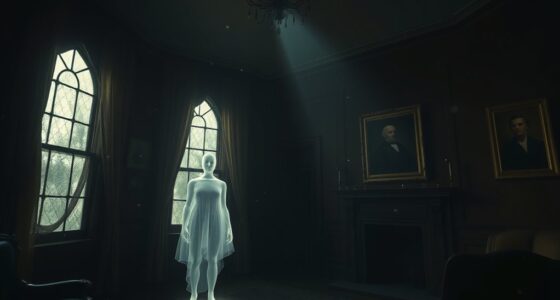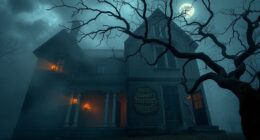Shadow people are mysterious, shadowy figures that often appear in low-light situations, especially during sleep paralysis. They have roots in various cultures’ folklore, such as the Jinn in Islamic stories and the Nalusa Chito in Choctaw traditions. Some believe they represent lost spirits or even interdimensional beings. You might feel an intense gaze from figures like the Hat Man. If you’re curious about their origins and cultural impact, there’s much more to explore.
Key Takeaways
- Shadow people are supernatural entities resembling dark silhouettes, often linked to cultural folklore and modern paranormal stories.
- The Hat Man, a specific type of shadow person, is recognized by his fedora and is commonly seen during sleep paralysis.
- Encounters with shadow people may be explained by psychological phenomena, such as hallucinations during sleep paralysis or heightened emotional states.
- Theories about shadow people’s origins range from lost human spirits to interdimensional beings or extraterrestrial entities.
- Popular culture has embraced shadow people, with media and online discussions contributing to their mystique and intrigue.
History and Folklore
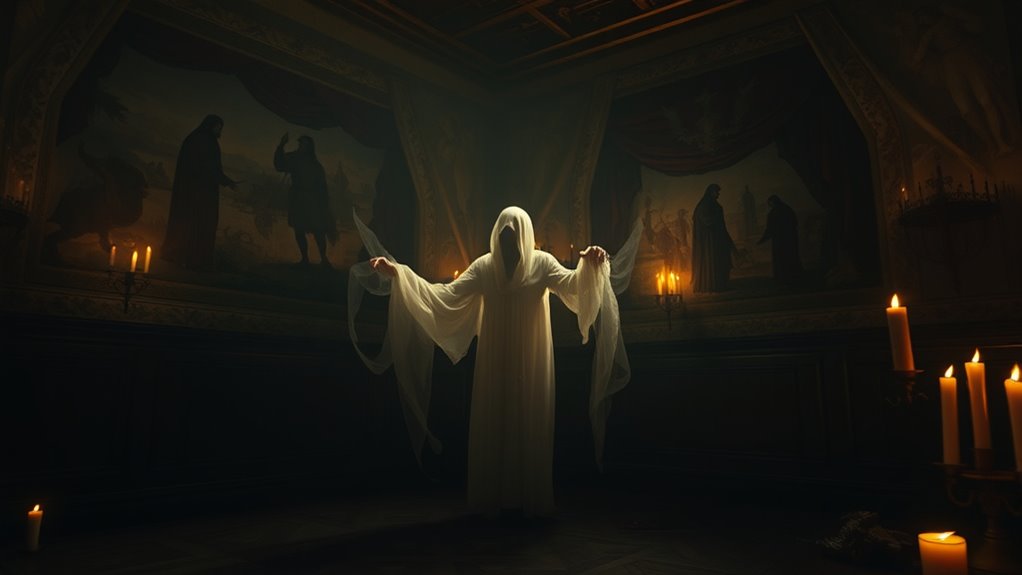
Throughout history, various cultures have described supernatural entities resembling shadow people, suggesting a shared fascination with these figures. For instance, Islamic folklore speaks of the Jinn, while the Choctaw people tell stories of the Nalusa Chito—both representing shadowy figures that intrigue and terrify.
In modern times, the concept really gained traction through programs like Coast to Coast AM, where listeners shared their eerie encounters. Heidi Hollis’ 2001 book helped shape contemporary views, depicting shadow people as dark silhouettes.
Opinions about these entities vary widely; some see them as malicious, while others believe they could be neutral or even helpful. Regardless of their nature, these shadowy figures continue to captivate our imagination and spark debate.
The Hat Man

While many shadow people evoke fear and intrigue, the Hat Man stands out as a particularly chilling figure. Often characterized by his distinctive fedora or brimmed hat, you might encounter this shadow person during episodes of sleep paralysis.
Witnesses describe him as lacking discernible features, yet you can feel an intense gaze directed at you. Sightings of the Hat Man typically coincide with heightened emotional states or the use of substances like diphenhydramine, which can disturb sleep.
Since the late 2000s, reports of this shadow person have gained traction, making him an iconic figure in modern paranormal folklore. He’s even transformed into a cultural reference, appearing as a horror villain on platforms like TikTok, further haunting our collective imagination.
Scientific Explanations
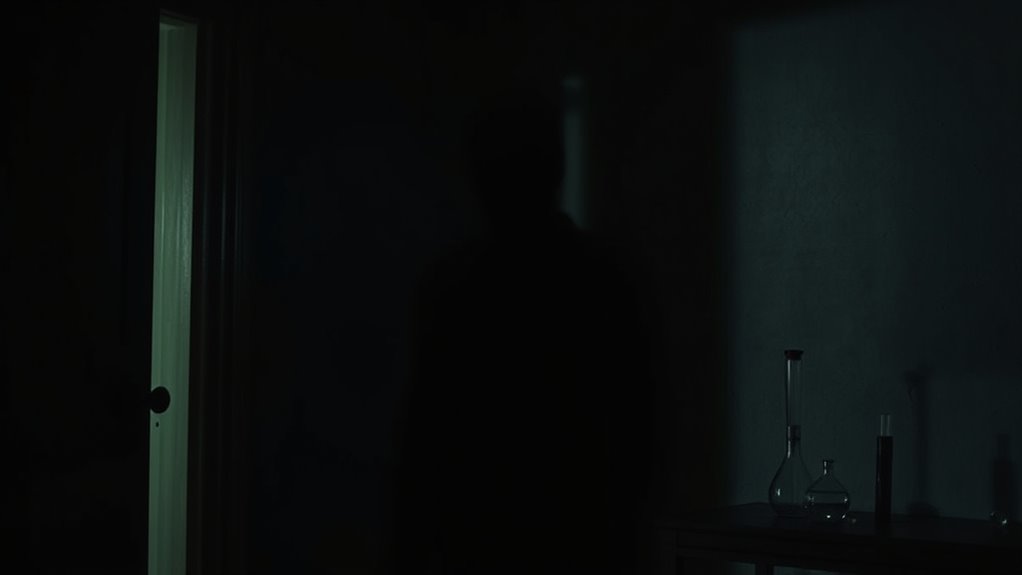
The chilling encounters with figures like the Hat Man often lead to questions about their origins. Many scientists suggest that shadow people might be psychological phenomena linked to sleep paralysis.
Chilling encounters with figures like the Hat Man raise intriguing questions about their psychological origins and links to sleep paralysis.
When you wake up but can’t move, your mind can create hallucinations of shadowy figures. Research shows that the left temporoparietal junction (TPJ) in your brain is essential for these experiences, sometimes making you feel as if someone’s watching you.
Heightened emotions like fear can distort your perception in low light, making shadows appear threatening. Additionally, conditions like schizophrenia or substance abuse, particularly methamphetamine use, can intensify these hallucinations.
Ultimately, your mind’s tendency to fill in visual gaps may transform ordinary shadows into the eerie forms of shadow people.
In Popular Culture
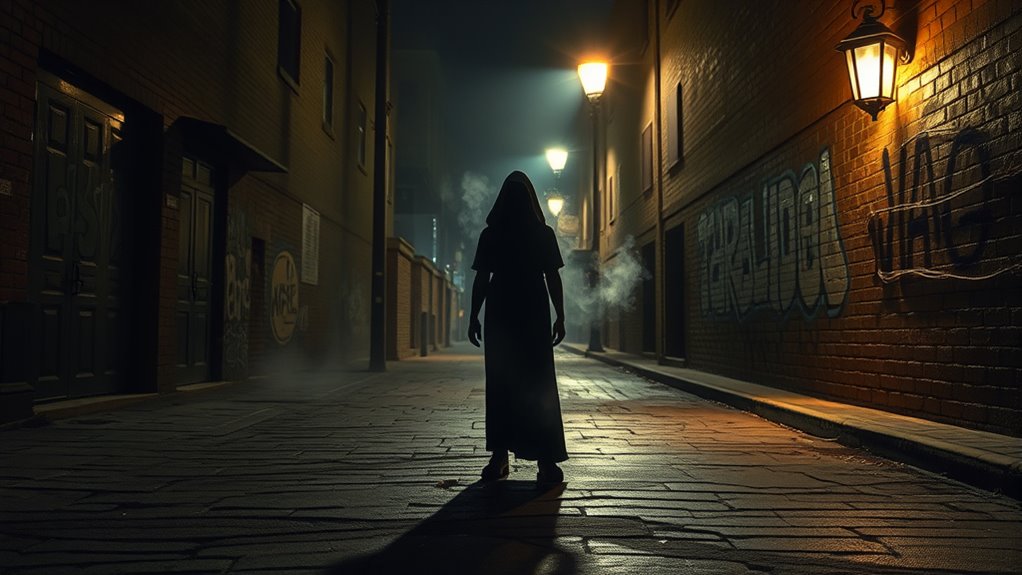
Shadow people have captured the imagination of many, becoming a fixture in popular culture that blends fear and fascination. Media outlets like Coast to Coast AM have popularized these mysterious entities, often linked with sleep paralysis. The Hat Man, a notable shadow person, is recognized for his fedora and is frequently featured in stories and online folklore.
Here’s a look at the presence of shadow people in various media:
| Medium | Description |
|---|---|
| The Twilight Zone | Episode “The Shadow Man” explores shadow people. |
| Shadow People Film | A horror film about a fictional sleep study. |
| A&E’s Intervention | Showcases a subject’s experiences with shadow people. |
| TikTok | Modern folklore featuring the Hat Man. |
| Paranormal Podcasts | Discussions on the nature of shadow people. |
Theories of Origin
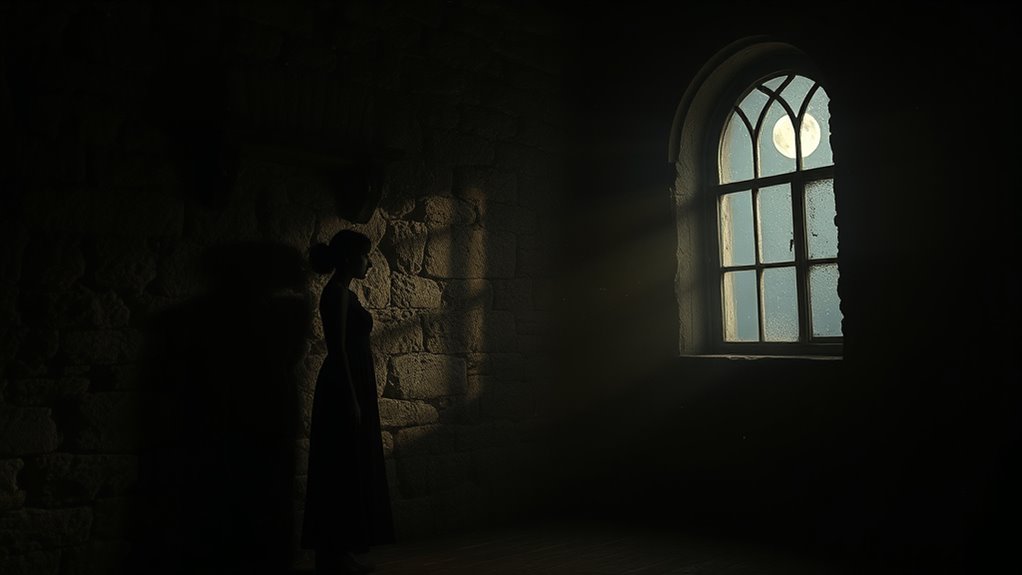
As you explore the theories surrounding the origins of shadow people, you’ll find a fascinating mix of folklore and modern interpretations. Some believe these Shadow Men are lost human spirits, while others argue they might be demonic entities, given the negative emotions often linked to sightings.
Their appearance, typically void of identifiable features or clothing, supports the notion that they aren’t ordinary ghosts but rather beings from different dimensions. Enthusiasts also speculate that shadow people could be interdimensional beings or even extraterrestrial entities, blending ancient lore with contemporary paranormal beliefs.
Additionally, psychological explanations suggest that heightened fear or anxiety might amplify perceptions of these shadowy figures, complicating our understanding of their true nature.
Frequently Asked Questions
What Mental Illness Makes You See Shadow People?
You might think seeing shadowy figures is just your imagination, but certain mental health conditions can cause these experiences.
Schizophrenia often includes visual hallucinations, leading you to perceive shadow people. Anxiety disorders and night terrors can also create feelings of dread and paralysis, making encounters feel real.
Additionally, substance use, like methamphetamine, can contribute to these perceptions. If you’re experiencing this, it’s essential to seek help and support from a mental health professional.
Why Do I See Shadow People in My House?
If you’re seeing shadow people in your house, it might stem from a combination of factors.
Stress, anxiety, or sleep deprivation can heighten your senses, making you more likely to perceive these figures. It could also relate to your environment—dim lighting or cluttered spaces might contribute to feelings of unease.
Consider your mental state and surroundings. Talking to someone about your experiences can help you find clarity and possibly ease your fears.
What Does Human Shadow Mean?
When you see human shadows, it often means your brain’s interpreting visual stimuli in a way that resembles a person. This can happen in low light or when you’re feeling anxious or tired.
Your mind might fill in blanks, creating shapes that look human. Some believe these shadows carry a deeper meaning, but scientifically, it’s usually just a trick of perception, influenced by your emotional state or the environment around you.
What Is the Difference Between Shadow People and Ghosts?
When you think about the difference between shadow people and ghosts, you’ll notice distinct characteristics.
Ghosts often appear as recognizable figures tied to human emotions or past events, while shadow people manifest as dark, featureless silhouettes without any emotional connections.
You might see ghosts in specific locations, but shadow people appear unexpectedly and transiently.
Unlike ghosts, shadow people lack accompanying phenomena, making them feel more elusive and mysterious in nature.
Conclusion
In the shadows of our understanding, shadow people linger, embodying both fear and intrigue. Whether you see them as figments of imagination, manifestations of sleep paralysis, or something more sinister, they challenge our perception of reality. As you explore their lore and the theories surrounding them, you might wonder: are these elusive figures merely reflections of our deepest fears, or do they hold secrets to dimensions beyond our sight? The truth, it seems, is shrouded in darkness.





